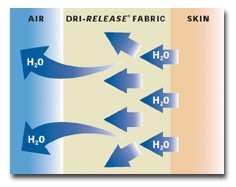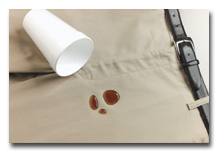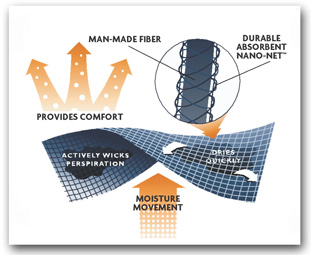”
T
oday’s industrial infrastructure is designed to chase economic growth. It does so at the
expense of other vital concerns, particularly human and ecological health, cultural and natural
richness, and even enjoyment and delight…. The waste, pollution, crude products, and other
negative effects [of most industrial methods and materials] are the consequence of outdated and
unintelligent design.”
So state architect and designer William McDonough and chemist Michael Braungart, Ph.D., in
their book “Cradle to Cradle,” in which they champion the importance of design in developing
environmentally intelligent, sustainable products and business strategies, looking to the natural
world to find practical approaches to reaching that goal.
Their strategies offer hope to companies that struggle to comply with government
regulations, helping them realize the economic growth they seek, in addition to providing product
differentiation. Manufacturers are surviving in today’s challenging and fiercely competitive global
business environment because they have reduced costs related to energy, waste disposal and
regulatory compliance. And their products are competing in the marketplace quality-for-quality on
price, performance and aesthetic appeal as well.
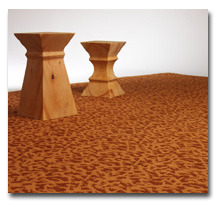 Origami broadloom carpet, made using BASF SAVANT™ nylon 6 yarn, from Patcraft Commercial
Origami broadloom carpet, made using BASF SAVANT™ nylon 6 yarn, from Patcraft Commercial
Carpet Division of Shaw Industries
Cradle To Cradle
“Sustainability is a destination, which is called cradle to cradle,” McDonough told
Textile World
in a recent interview. Through Charlottesville, Va.-based McDonough Braungart Design
Chemistry (MBDC), McDonough and Braungart have consulted with corporations worldwide, including
such textile manufacturers and suppliers as Cargill Dow LLC, BASF Corp., Shaw Industries Inc.,
Rohner Textil AG and others – helping them chart a new course by reevaluating their operations and
setting goals to implement eco-effective, and even restorative, practices. These companies are
turning “strategies of tragedy” into “strategies of change,” redesigning products to use more
eco-friendly chemicals and processes, eliminate much of their pollution and waste, and also provide
food for future manufacturing appetites and for the earth.
McDonough and Braungart contrast the cradle-to-cradle, regenerative life cycle of
sustainable products with the cradle-to-grave concept of products whose components cannot be
separated and perpetually recycled into virgin-quality materials and ultimately end up as waste.
But even the idea of waste must be reevaluated in this context. In a cradle-to-cradle cycle, “waste
equals food,” McDonough and Braungart assert. It provides nutrition in a biological, compostable
cycle or in a closed-loop, technical, manufacturing cycle.
 Victor Innovatex’s environmentally optimized Eco Intelligent™ Polyester upholstery
Victor Innovatex’s environmentally optimized Eco Intelligent™ Polyester upholstery
fabric
Biological Or Technical Nutrition
“On the biological nutrient side, we have propitious, biological, organic products, and that
means we have to go right back to their origin and their processing,” McDonough said. “We also have
biodegradable materials made from petroleum products. What’s exciting will be biological nutrient
fibers made from secondary agricultural products – PLA [polylactide], for example, made from straws
and stalks, not from kernels. Otherwise, we’re making our fabrics out of food.
“As for petrochemical-based materials, we see them going either into biologically based
products that break down into carbohydrate or into technical services products, like polyesters and
nylons,” he said. “The biggest message to the ecologically concerned markets is how critical it is
that we have man-made products in cradle-to-cradle life cycles.”
Minnetonka, Minn.-based Cargill Dow’s NatureWorks™ PLA biodegradable polymer resin is
derived from fermented corn sugars. It also will be chemically recyclable into new virgin-quality
resin once the infrastructure is in place to process it, according to Michael O’Brien, Cargill
Dow’s communications leader.
In its production, PLA reduces the use of fossil resources by up to 50 percent over
petrochemical-based polymer production. Greenhouse gas emissions are reduced by 15 to 60 percent.
Cargill Dow projects these reductions eventually could reach 80 to 100 percent.
The company is using grants from the US Department of Energy (DOE) to fund further research
and development. One grant is being used to help develop technology to derive PLA from non-food
parts of the corn plant. Another is helping Cargill Dow explore changing its energy feedstock.
“This opens the door to allow us to make our own energy from renewable sources,” O’Brien said.
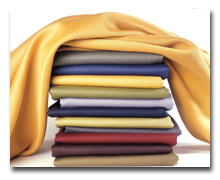 Climatex® Lifecycle™ upholstery fabrics from DesignTex
Climatex® Lifecycle™ upholstery fabrics from DesignTex
Nylon 6: Closing The Loop
One example of technical nutrition is closed-loop nylon 6 recycling. For McDonough, its
eco-effective, cradle-to-cradle – as opposed to merely eco-efficient – nature means its
consumption can be celebrated rather than decried as being wasteful. “Here is a material that is
durable, color-retentive, stain-resistant, lasts as long as you’d ever want it to – and, in fact,
lasts as short as you want it to,” he said. “The fact that you can turn it back into itself means
guilt disappears, and if you want to change your carpet from blue to pink after three years, we
don’t care because all you do is create jobs.”
BASF, Mount Olive, N.J., established its Ontario-based 6ix Again® recycling program in 1994
to depolymerize used nylon 6 carpet fiber into caprolactam and water. The caprolactam is then
repolymerized into virgin-quality nylon 6 polymer. BASF recycles carpet containing its own BASF
Nylon 6ix® products, including SAVANT™ advanced engineered fiber containing 50-percent recycled
content, Ultramid®, Zeftron® and solution-dyed Zeftron 2000; and any other nylon 6 carpet, as well
as upholstery fabrics made from solution-dyed Zeftron 200 nylon. It also accepts and processes
nylon 6,6 and backing systems. Tim Blount, BASF’s carpet products marketing manager, reports the
program has diverted millions of pounds of nylon from landfills.
“In today’s sustainability-conscious commercial marketplace, there is increased interest and
demand for fully renewable high-performance products,” Blount said. “Our carpet mill customers, as
well as the architect and design and specifying communities, are showing a high level of interest
in the environmental attributes of the products we manufacture, as well as in ensuring a proper
infrastructure for managing carpets once they have reached the end of their useful lives.”
 William McDonough (left) and Michael Braungart, Ph.D.
William McDonough (left) and Michael Braungart, Ph.D.
Carpet Face And Backing: Separate Pathways
Dalton, Ga.-based Shaw Industries Inc. offers carpets using BASF’s SAVANT fiber and, through
its Shaw Commercial Division, produces its own EcoSolution Q™ nylon 6 fiber for other carpet
products. Steven L. Bradfield, vice president, environmental development, said most of its nylon 6
products, which comprise well over half of its total commercial carpet production, contain a
minimum of 25-percent recycled content. Its annual consumption of recycled nylon 6 totals more than
20 million pounds. In addition, Shaw’s total manufacturing operations recycle 75 percent of its
production waste.
Bradfield said carpet must be seen in terms of both its face and its backing. “If you look
at carpet as just a single entity that you’re going to melt down and turn into something, then that
something is not going to be the same carpet it was before. If you take the idea that it’s a face
and a backing, there are carpets at Shaw that we can actually separate and return to their original
pathways,” he said.
Bradfield pointed to Shaw’s EcoWorx™ polyolefin thermoplastic carpet backing as an example.
“[It] flows directly onto the back of the carpet cloth. It’s a non-PVC [polyvinyl chloride]
backing, and it’s our largest-volume tile or six-foot backing – over 50 percent of our volume in
these product types,” he said. “EcoWorx meets or exceeds PVC testing and performance in every
category. We developed EcoWorx for greater backing choice, for reducing material environmental
impacts, for its lower long-term cost, and for its compatibility with nylon 6 breakdown.”Shaw is
ramping up capacity for EcoWorx production to provide all of its backing for carpet tile and
six-foot modular carpet, and plans eventually to provide it for its high-performance broadloom
carpet as well. The company also is evaluating its manufacturing processes, energy flux and raw
materials to further develop its cradle-to-cradle strategy.
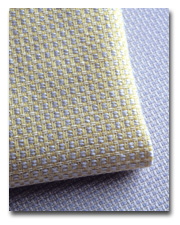 PLA upholstery fabrics from Interface Fabrics Group
PLA upholstery fabrics from Interface Fabrics Group
Fabrics “Safe Enough To Eat”
Businesses can incur significant expense in order to comply with environmental and safety
regulations. McDonough holds up Switzerland-based Rohner Textil as an example for US textile
companies facing the need to cut costs in this country or go offshore.
MBDC worked with Rohner and New York City-based DesignTex, a division of Steelcase, to
develop a biodegradable upholstery fabric that would be “safe enough to eat.” At the time, Rohner,
which had been complying with all the Swiss environmental regulations, found its fabric trimmings
had been declared hazardous waste that could no longer be disposed of locally, and so had to be
shipped to Spain.
The new fabric, Climatex® Lifecycle™, combines organically grown ramie with wool, and is
dyed and finished using 16 nontoxic dyes and 22 auxiliaries and processing chemicals from
Switzerland-based Ciba Specialty Chemicals Inc. Effluent tested since production began is cleaner
than the water coming into the plant, and the fabric trimmings can be processed into felt for
upholstery interliners or gardening mulch. As McDonough and Braungart tell the story, “Not only did
our new design process bypass the traditional responses to environmental problems (reduce, reuse,
recycle), it also eliminated the need for regulation, something that any businessperson will
appreciate as extremely valuable.”
“Rohner was able to cut its costs by 20 percent because it got rid of regulation and was
able to remove all sorts of restrictions on the way its people could function,” McDonough said. “It
could get rid of protective equipment; it doesn’t have a percentage of its building allocated to
hazardous materials storage; and it doesn’t have any cost of hazardous waste being shipped to
Spain.” The mill’s products also have been very successful in the marketplace.
“What was the other way to save costs for a company like Rohner?” McDonough asked. “Go
offshore. And then, what happens to all those people with all that expertise in Switzerland? This
is a critical agenda for the US textile industry. It can move into an unregulated event and compete
with other places that are unregulated, but instead of being unregulated because nobody’s paying
attention, it’s unregulated because it’s not hurting anybody. It’s a great way to differentiate
quality.”
Rohner licenses its Climatex technology to other textile makers, including Victor Innovatex,
Canada, which supplies DesignTex with Climatex LifeguardFR™, a fire-retardant (FR) fabric using
wool and Austria-based Lenzing AG’s Redesigned LenzingFR™ cellulosic fiber treated with
Switzerland-based Clariant’s nontoxic FR finish. Climatex fabrics also are available from Carnegie,
Rockville Centre, N.Y.
 Ray C. Anderson, Interface chairman
Ray C. Anderson, Interface chairman
Interface: An Epiphany
Ray C. Anderson, chairman of Atlanta-based Interface Inc., relates his company’s journey
toward sustainability in his book, “Mid-Course Correction: Toward a Sustainable Enterprise: The
Interface Model.” From its beginnings in 1973, Interface had sought simply to comply with
environmental regulations, but in 1994, Anderson read “The Ecology of Commerce” by Paul Hawken and
experienced an epiphany. In that book, Hawken calls on business and industry to take the lead in
reversing the environmental damage that has been wrought on Earth.
Anderson challenged Interface to play a premier role in the sustainability movement,
ultimately “putting back more than we ourselves take and doing good to Earth, not just no harm – by
helping or influencing others to reach toward sustainability.” Since 1996, Interface has reduced
its environmental footprint by one-third and cut operational waste by as much as half in some
facilities, saving $209 million; reduced harmful emissions and increased its energy efficiency,
reducing nonrenewable process energy by 18 percent; and reduced water consumption per unit of
modular carpet production by 68 percent.
Eight Interface facilities generate renewable energy on-site or purchase green power. In
2001, green energy sources – including solar, wind, landfill gas, biomass and hydroelectric –
provided 8.5 percent of the company’s power needs worldwide. Two facilities in the United Kingdom
purchase all of their electricity from green sources. By mid-2003, the company’s plant in Canada
expects to be totally powered by wind.
The company also has committed to using closed-loop, recycled raw materials and to reducing
the amount of petroleum-derived raw materials, as sustainable technologies fall into place. Use of
non-petrochemical-based materials in Interface products has increased by 24 percent since 1994.
Interface Fabrics Group plans to introduce new PLA fabrics in its Terratex line by the end of this
year, according to Wendy Porter, director of environmental management.
Product designer David Oakey said one-third of Interface product now contains recycled
content. Oakey designs products to reduce waste, sometimes creating random designs, such as those
found in Interface’s Entropy™ line of carpet tiles, in order to reduce leftover materials.
Anderson is firm in his belief that industry must find ways to become sustainable. “If we
don’t figure out how to do it, the industrial system will collapse,” he warns. He believes
Interface’s green initiatives are helping it survive in the current economic climate, stating,
“Sustainability has transformed Interface into a company that is doing well by doing good.”
Products Of Service
One solution to reducing landfill waste involves selling the service of a product – in
effect leasing the product to the customer and retaining ownership of its components, while
servicing and upgrading it as often as desired within a defined period of use. In describing a
product of service, McDonough encourages a rethinking about the nature of a product. “The concept
has to be transparent to customers in terms of their options. Even though they buy the product,
it’s effectively like a lease because the company wants it back as technical nutrition,” he
explained. The product must be designed to be cradle to cradle, and the manufacturer’s relationship
with the customer is optimized and maintained because the product is returned for reprocessing, he
said.
Reaching The Destination
MBDC’s Design Protocol for creating cradle-to-cradle products recognizes levels of
environmental intelligence ranging from simply being free of a known toxic substance to being fully
eco-effective – “pure innovation,” McDonough said, citing as examples “a new kind of floor covering
or a whole new way of making carpet that is designed to be cradle to cradle from scratch – or a new
textile made from agricultural secondaries grown organically without petrochemical fertilizers and
using wind power for processing.”
But, he added, “The perfect product is going to be a pioneer in its own territory. The
perfect carpet – designed with all new materials that are totally without all the residuals of all
the wrong components – would never be given points in the marketplace or by green industry
standards, because it didn’t exist when the industry did a consensus process.
“We’re looking for the highest performance around sustainable criteria,” he continued, “not
the lowest common denominator that can be used as a threshold for entry into the club of hope.
We’re looking for champions and fierceness.”
March 2003

